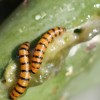 These caterpillars roll up leaves of the host plants and use the rolled leaves as larval retreats and locations for pupal cocoons. Although these leaf-eating pests do no permanent damage, they can completely defoliate fiddlewood, a Florida native that can form a large shrub or small tree. The shrub simply puts out a new flush of leaves. The larvae themselves are valuable food source for baby birds during the spring dry season in Florida. This 4-page fact sheet was written by William H. Kern, and published by the UF Department of Entomology and Nematology, February 2015. (Photo:W.H. Kern, Jr., UF/IFAS/FLREC)
These caterpillars roll up leaves of the host plants and use the rolled leaves as larval retreats and locations for pupal cocoons. Although these leaf-eating pests do no permanent damage, they can completely defoliate fiddlewood, a Florida native that can form a large shrub or small tree. The shrub simply puts out a new flush of leaves. The larvae themselves are valuable food source for baby birds during the spring dry season in Florida. This 4-page fact sheet was written by William H. Kern, and published by the UF Department of Entomology and Nematology, February 2015. (Photo:W.H. Kern, Jr., UF/IFAS/FLREC)
http://edis.ifas.ufl.edu/in1079
Tag: Pyralidae (snout moths)
Cactus Moth, Cactoblastis cactorum (Berg) (Insecta: Lepidoptera: Pyralidae) (EENY056/IN213)
 Since its arrival in the Florida Keys in 1989, this invasive species has become a serious threat to the diversity and abundance of Opuntia cactus in North America. The spread of this moth raises concerns about harm to rare opuntioid species (prickly pear and related cacti), the endangerment of wild opuntioids in the southwestern United States and Mexico and the consequent effects on entire desert ecosystems and economic hardship for communities in Mexico that cultivate and sell Opuntia. This 5-page fact sheet was written by D. H. Habeck, F. D. Bennett, and Christine Miller, and published by the UF Department of Entomology and Nematology, September 2012.
Since its arrival in the Florida Keys in 1989, this invasive species has become a serious threat to the diversity and abundance of Opuntia cactus in North America. The spread of this moth raises concerns about harm to rare opuntioid species (prickly pear and related cacti), the endangerment of wild opuntioids in the southwestern United States and Mexico and the consequent effects on entire desert ecosystems and economic hardship for communities in Mexico that cultivate and sell Opuntia. This 5-page fact sheet was written by D. H. Habeck, F. D. Bennett, and Christine Miller, and published by the UF Department of Entomology and Nematology, September 2012.
http://edis.ifas.ufl.edu/in213